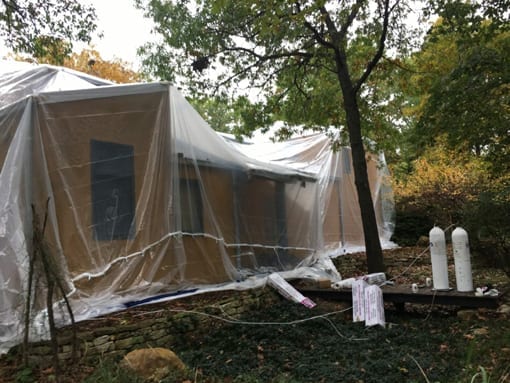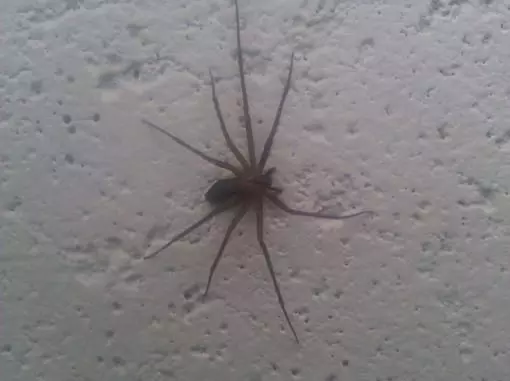Brown Recluse Spider Elimination Using Vikane Gas

Have Brown Recluse Spiders? Want them Gone? No worries, let us tarp your home and insert Vikane Gas into your home to kill all stages of Brown Recluse Spiders in your Kansas City home. We can kill all Brown Recluse stages in your home in as little as 3 to 5 days using one treatment method, Vikane gas.
The brown recluse, Loxoceles recluse, is the most publicized and feared spider in the Greater Kansas City Area.
The venom from the brown recluse is hemotoxic and causes necrosis of the tissue: a bleeding, ulcerous wound which takes a long time to heal in the young and elderly. The wound can be prone to secondary infection if not treated properly. The brown recluse thrives in and around human structures. Most homes in Kansas and Missouri have brown recluse spiders affecting their structures.

The brown recluse spider in Kansas City is a medium-sized spider about the size of a quarter. The brown recluse is covered with short hairs and has six eyes arranged in a semicircle. Magnification may be necessary to see the arrangement of the six eyes. A violin-shaped marking may be the most distinguishing characteristic of the brown recluse, whether young or old, male or female. It should be noted the neck of the violin points towards the abdomen (rear) of the spider.
Depending on the temperature, the brown recluse can develop from egg to adult in 8 to 15 months. Importantly the brown recluse is relatively durable, and long-lived usually live about 2 to 3 years or more. Female brown recluse spiders construct up to five egg sacs, each egg sac containing 20 to 50 eggs. Egg sacs primarily can be found attached to walls and other surfaces, including plants, boxes, and furniture. It should be noted that spiderlings emerge in 3 to 5 weeks and remain on the web with the mother. Continuing for 2 to 3 skin sheddings before looking for their suitable habitat. The new spiderlings shed (molt) six or seven times before reaching adulthood.
This spider feeds on insects, which include other spiders and arthropods. Interestingly enough, the brown recluse does not construct webs to capture its prey. The brown recluse uses a bite and retreat method, coming back to consume its prey later. Without a doubt, this spider is a quick and active hunter, prefers to move around and hunt at night.
This spider usually hides in dark areas, undisturbed areas like under boxes, in piles of books and papers, and furniture. Nighttime is when these spiders generally start to roam in search of food. This spider begins to look for dark hiding places such as piles of clothing, shoes, toys, or anything lying on the floor as daylight approaches.
In homes with considerable clutter and stored items, this spider can be more common with older homes where natural aging and settling occur due to settling cracks and crevices. Interestingly, though, the brown recluse searches out warm, dry habitats with little air movement and low light. This includes attics and upper rooms. Importantly this keeps the spiders out of sight and away from living spaces. Ideally, those areas become too hot, or food becomes too scarce; they will relocate to other home parts.
These spiders generally don't bite humans unless as a defense when trapped against the skin. If bitten, the reaction to the bite from brown recluse depends on the victim's health. The amount of venom injected, the spider's size, and the bite location makes a lot of difference in how humans react to the brown recluse spider bites in Kansas City. In rare cases, the venom from brown recluse may cause a life-threatening illness. Bites are usually painless. Most of the victim is not aware of being bitten until signs start to show. Mostly if a brown recluse spider has bitten you in Kansas City, apply ice to the location and consult with medical care professionals. Treatments vary, and early diagnosis is essential. If possible, capture the specimen to show to the medical professional.
Unless you use Vikane gas for complete fumigation of your home, eliminating brown recluse spiders from your structure may be difficult. Using an integrated approach to reduce harborages moves in the right direction when trying to control brown recluse spiders. Remove clutter from your home, starting with the attic, upper rooms, main level, and basement. Frequently using a vacuum wand to reach between boxes and other tight spaces will help eliminate spiders; their egg sacs and potential food sources are critical. Sticky traps can be used to monitor brown recluse spiders. These can be found at any local hardware store. Undoubtedly, traps can help monitor and control populations. Precisely place the traps around the home in areas where spiders are likely to travel for better results. It should be noted, the use of liquid chemistries to control brown recluse spiders is limited.
